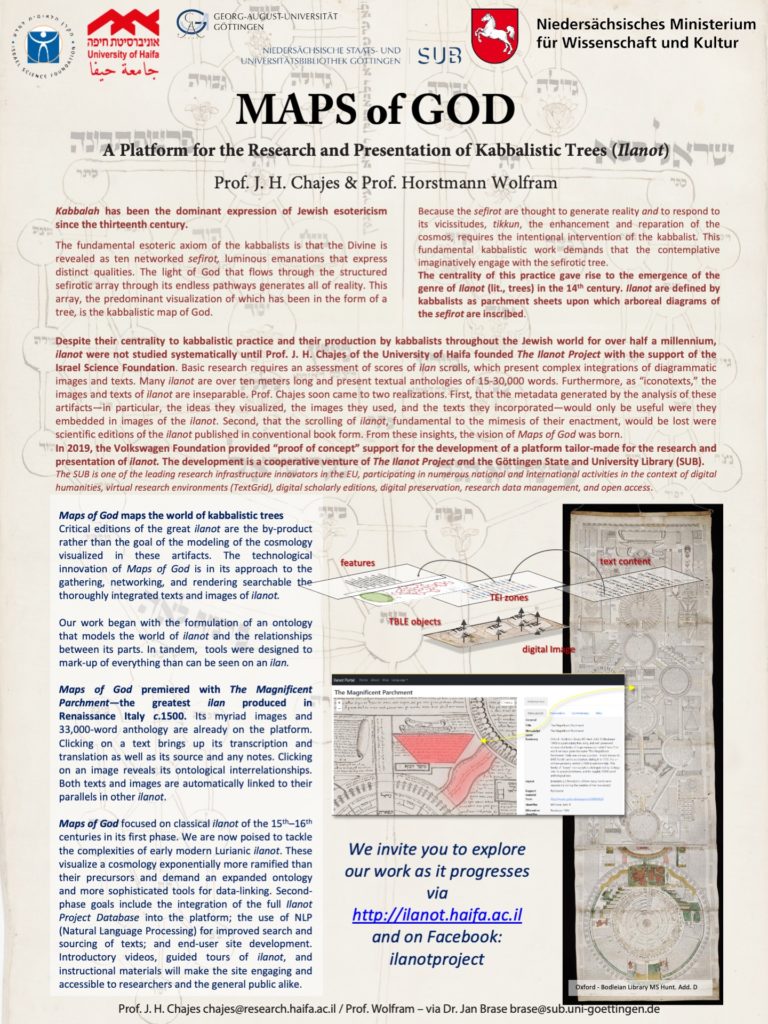Maps of God – Digital Humanities Project – Prof. J. H. Chajes, Director
A Volkswagen Foundation supported Digital Humanities German-Israel Partnership in collaboration with the Göttingen State and University Library
Dr. Eliezer Baumgarten, Digital Humanities Project Leader, University of Haifa, Ilanot Project
Keren Barner – Project Liaison, Digital Humanities at the Younes and Soraya Nazarian Library at the University of Haifa
Kabbalah has been the dominant expression of Jewish esotericism since the thirteenth century.
The fundamental esoteric axiom of the kabbalists is that the Divine is revealed as ten networked sefirot, luminous emanations that express distinct qualities. The light of God that flows through the structured sefirotic array through its endless pathways generates all of reality. This array, the predominant visualization of which has been in the form of a tree, is the kabbalistic map of God.
Because the sefirot are thought to generate reality and to respond to its vicissitudes, tikkun, the enhancement and reparation of the cosmos, requires the intentional intervention of the kabbalist. This fundamental kabbalistic work demands that the contemplative imaginatively engage with the sefirotic tree.
The centrality of this practice gave rise to the emergence of the genre of Ilanot (lit., trees) in the 14th century. Ilanot are defined by kabbalists as parchment sheets upon which arboreal diagrams of the sefirot are inscribed.
Despite their centrality to kabbalistic practice and their production by kabbalists throughout the Jewish world for over half a millennium, ilanot were not studied systematically until Prof. J. H. Chajes of the University of Haifa founded The Ilanot Project with the support of the Israel Science Foundation. Basic research requires an assessment of scores of ilan scrolls, which present complex integrations of diagrammatic images and texts. Many ilanot are over ten meters long and present textual anthologies of 15-30,000 words. Furthermore, as “iconotexts,” the images and texts of ilanot are inseparable. Prof. Chajes soon came to two realizations. First, that the metadata generated by the analysis of these artifacts—in particular, the ideas they visualized, the images they used, and the texts they incorporated—would only be useful were they embedded in images of the ilanot. Second, that the scrolling of ilanot, fundamental to the mimesis of their enactment, would be lost were scientific editions of the ilanot published in conventional book form. From these insights, the vision of Maps of God was born.
In 2019, the Volkswagen Foundation provided “proof of concept” support for the development of a platform tailor-made for the research and presentation of ilanot. The development is a cooperative venture of The Ilanot Project and the Göttingen State and University Library (SUB).
The SUB is one of the leading research infrastructure innovators in the EU, participating in numerous national and international activities in the context of digital humanities, virtual research environments (TextGrid), digital scholarly editions, digital preservation, research data management, and open access.
Maps of God maps the world of kabbalistic trees
Critical editions of the great ilanot are the by-product rather than the goal of the modeling of the cosmology visualized in these artifacts. The technological innovation of Maps of God is in its approach to the gathering, networking, and rendering searchable the thoroughly integrated texts and images of ilanot.
Our work began with the formulation of an ontology that models the world of ilanot and the relationships between its parts. In tandem, tools were designed to mark-up of everything than can be seen on an ilan.
Maps of God premiered with The Magnificent Parchment—the greatest ilan produced in Renaissance Italy c.1500. Its myriad images and 33,000-word anthology are already on the platform. Clicking on a text brings up its transcription and translation as well as its source and any notes. Clicking on an image reveals its ontological interrelationships. Both texts and images are automatically linked to their parallels in other ilanot.
please have a very sneak peek at our pre-Alpha work here: https://ilanot.org/
Maps of God focused on classical ilanot of the 15th–16th centuries in its first phase. We are now poised to tackle the complexities of early modern Lurianic ilanot. These visualize a cosmology exponentially more ramified than their precursors and demand an expanded ontology and more sophisticated tools for data-linking. Second-phase goals include the integration of the full Ilanot Project Database into the platform; the use of NLP (Natural Language Processing) for improved search and sourcing of texts; and end-user site development. Introductory videos, guided tours of ilanot, and instructional materials will make the site engaging and accessible to researchers and the general public alike.




